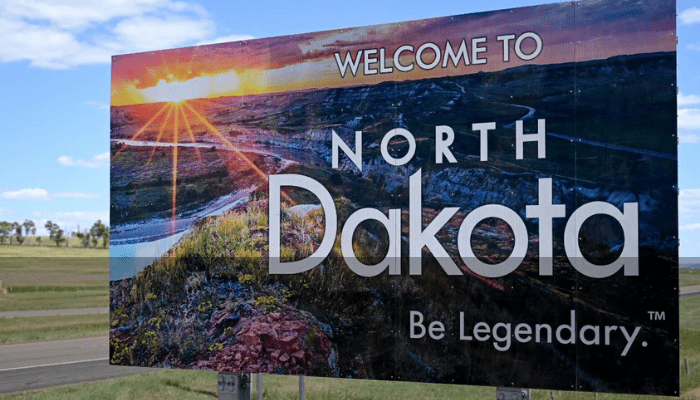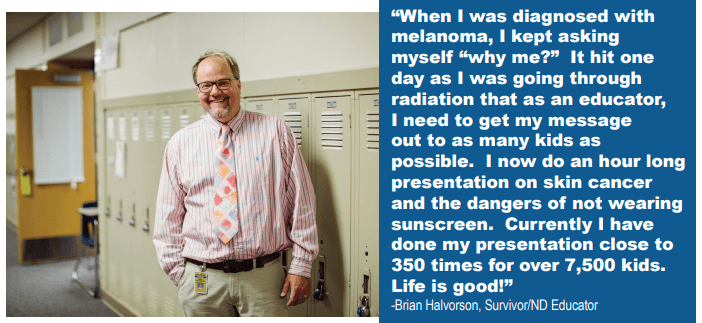Melanoma by the State: North Dakota

North Dakota Wants Residents to Protect Their Skin
North Dakota is a farming and ranching state, with 39.1 million acres — nearly 90% of the land area — comprising farms and ranches. The state is home to more wildlife refuges (63) than any other state, and one lake, Lake Sakakawea, has more shoreline than the California Pacific Coast. The weather in North Dakota varies greatly, and according to the North Dakota state website, reports of never-ending bone-chilling cold are greatly exaggerated. All of which means North Dakota is a state whose residents spend a solid amount of time outside.
The state’s melanoma rate may reflect this outdoor life: In 2016 the incidence rate for women was 21.3 per 100,000 and for men it was 24.3 per 100,000.
“I think the melanoma increases we are seeing in men in particular probably are linked with lower use of sunscreen, working outside when the sun’s rays are at their most damaging, and wearing ‘ball caps’ instead of more protective hats,” says Julie Garden-Robinson, Ph.D., R.D., L.R.D., professor and Extension food and nutrition specialist at North Dakota State University. “We also have a lot of fair-skinned people in our state, who may be more susceptible to the damaging rays of the sun.”
The North Dakota Extension work was informed by a 2011 Wisconsin study, where researchers did a skin cancer screening with 476 participants, including 194 farmers. They found that just 23% of farmers used sunscreen always or frequently. The participants said that wearing long-sleeved shirts and wide-brimmed hats was an inconvenience. The participants often forgot to wear sunscreen.
For both men and women, melanoma is the fourth most common cancer in North Dakota, and the incidence rate is rising for both sexes. An estimated 230 cases were diagnosed in the state in 2019.
Luckily for North Dakotans, they have an active and caring Cancer Coalition. A few years ago, the North Dakota Cancer Coalition assigned a steering committee the task of finding a cancer on which to focus their efforts. The steering committee looked at each area of cancer and what work was already happening. They used data to identify focus areas that did not have much work or effort around them, as they did not want to duplicate efforts. They identified what organizations were doing work, if any, and identified gaps in the community. They selected melanoma in 2018.
Work began immediately. Right away, they felt that a patient story would impact providers and community, so they worked with a melanoma patient named Brian Halvorson, who recorded “Brian’s Story.”
Brian is a teacher, and he knew his message about protecting your skin while you are young is an important one to deliver to kids like those in his own class. He did not want them to make the same mistakes as he did. Since his diagnosis, he has given over 525 melanoma presentations and reached over 1,000 children through these presentations.

Other education efforts were also launched, aimed at both children and adults. For example, last year, 3,000 packets of sunscreen were disseminated, and Richland County hosted one “Ag Day” event in partnership with North Dakota State University (NDSU) Extension on sun safety. In North Dakota’s ongoing “Healthwise” programs the coalition has reached out to both men and women with sun safety information.
Because people are often not aware of the risks of too much sun exposure, the NDSU Extension network uses an educational tool called a Dermascan, which shows a participant where potential sun damage has occurred on their skin. The goal is to prompt a visit to a healthcare provider when a participant sees a spot through the Dermascan. In a couple of cases, skin cancer was detected in follow-up visits with a medical professional, and the person received prompt treatment.
NDSU Educators reached more than 1,200 farmers, gardeners, and other outdoor workers with direct programming on skin cancer prevention strategies. In addition, they reached 5,000 children annually with sun safety education programs in schools, camps, and 4-H clubs. According to coalition surveys, nearly every participant planned to make at least one change in their behavior. The coalition also reached more than 10,000 people through Facebook with sun safety messages in 2020.
Brian’s Story and other sun safety videos were aired throughout the summer in an attempt to educate the public. The group also created animated Be Sun Safe videos for the general public: Protect your Skin, Sunless Tanning, and Which SPF is Best?
Finally, the group developed a UV Safety Toolkit, Sun Safety Activity pages, and a fact sheet. The toolkit includes activities for all age groups to learn about the effects of the sun and what we can all do to prevent skin damage. Interested users can view the UV Tool-kit Resource page to help determine what activities would be best for a proposed audience. The Resource page includes the ages the activities are meant to help users better select appropriate activities. The Sun Safety Activity pages are intended for preschoolers through sixth grade and include word searches, crossword puzzles, and classroom lesson ideas. And the colorful and informative fact sheet illustrates the rising melanoma rates in North Dakota as well as tips for prevention and objectives for early detection.
The coalition also recognized a need for professional education on the state incidence rates. This information was on the cancer registry website but not in front of professionals, so they are partnering with the University of North Dakota on deploying a survey to primary care providers to determine the comfort level of diagnosing skin cancer. The coalition will develop action plans based on the results.
What about indoor tanning in North Dakota? The state does have a ban, which prohibits minors under 14 from using tanning devices without a physician’s written prescription. Parents/guardians must accompany minors under 14 on all visits. It requires parent/guardian in-person written consent for minors under 18. The consent is valid for 12 months. There is no further pending legislation at this time.
Congratulations to North Dakota on identifying the rising incidence rate of melanoma and collaborating on ways to reduce that rate and keep residents safe while they ranch, farm, and enjoy the beautiful outdoor areas of their state.
Recent Posts

A Conversation with Dr. Rena Szabo, PsyD on Empowering Patients

Empowering Women in Melanoma: A Look Inside the Women in Melanoma Initiative

Melanoma News and Highlights You Don’t Want to Miss

Coping with Cancer: DBT Skills for Emotional Resilience


